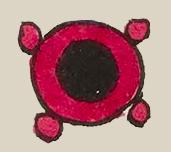tezcatl (Mdz42r)
This element has been carved from the compound sign for the place name, Atezcahuacan. It consists of a mirror, i.e. a reflective piece of obsidian or mica (tezcatl), shown as is a large red circle with a black concentric circle in the middle. Around the edges are four small red circles.
Stephanie Wood
If mirrors were typically made of mica or shiny obsidian, then this sign's shape is also reminiscent of other stone shapes, such as the chalchihuitl (jade) sign, and the xihuitl (turquoise) sign. The four small circles fairly evenly placed around the larger circle create a quincunx or quadripartite effect, possibly connecting the shine off of a mirror with the sparkling of the sun. See, for example the sign representing ilhuitl (day) on the splash page of this database or tonatiuh (sun, day). Our Online Nahuatl dictionary provides examples of the association between mirrors and light, or sunlight, and also human eyes.
See Ian Mursell's article in Mexicolore on "smoking mirrors" for information about the use of mirrors in Mesoamerica from pre-Classic times forward, their use in divination, and their association with divine forces.
Stephanie Wood
c. 1541, but by 1553 at the latest
Stephanie Wood
espejos, mirrors

tezca(tl), mirror, https://nahuatl.wired-humanities.org/content/tezcatl
mirror or glass
el espejo
Stephanie Wood
Codex Mendoza, folio 42 recto, https://digital.bodleian.ox.ac.uk/objects/2fea788e-2aa2-4f08-b6d9-648c00..., image 94 of 188.
The Bodleian Libraries, University of Oxford, hold the original manuscript, the MS. Arch. Selden. A. 1. This image is published here under the UK Creative Commons, “Attribution-NonCommercial-ShareAlike 3.0 License” (CC-BY-NC-SA 3.0).

